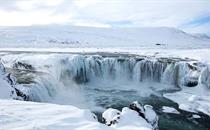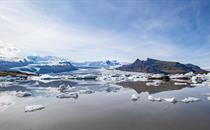FREQUENTLY ASKED QUESTIONS ABOUT VISITING ICELAND IN MARCH
Is March a good time to visit Iceland? Yes! What should I pack for a trip in March? What are the best things to do at that time of year? We’ve got you covered. Read on for the answers from our local travel experts to your most commonly asked questions.
How is Iceland in March?
March is a quiet month to visit Iceland as it falls during the winter, which is the off-peak season for tourism.
It is an ideal time if you want to experience the Icelandic winter, take part in snow-based activities like snowmobiling, or even hunt for the northern lights. Though the weather is colder at this time of year, you will also enjoy smaller crowds at top attractions.
What are the best things to do in Iceland in March?
Whether you want to enjoy a cultural break in Reykjavík or a cosy winter getaway in the countryside, a trip to Iceland in March will bring you some fantastic holiday experiences. Even with the winter weather in March, there are still plenty of festivals to attend, nature adventures to participate in and snow-covered landscapes to admire.
Here are 10 of the best things to do in Iceland in March:
-
Drive along the Ring Road
-
Discover the famous Golden Circle
-
Marvel at mighty waterfalls
-
Hunt for the northern lights
-
Dip in hot springs and pools
-
Venture along the Snæfellsnes peninsula
-
Go on a horse riding or whale watching tour
-
Satisfy your taste buds at the Reykjavík Food and Fun Festival
-
Join in the celebration of Beer Day on 1 March
-
Attend the DesignMarch festival in Reykjavík
One of the coolest things to do in Iceland in winter is ice caving in Vatnajökull – the largest glacier in Europe. The caves are naturally formed every year as the glacial meltwater freezes, creating tunnels of ice that you can walk through safely with a guide.
There are more ways to enjoy the snow and ice in winter. You could go snowmobiling on the Langjökull glacier, or try snowshoeing through white landscapes and skiing down powdery slopes. Another fantastic activity is to ride a purebred Icelandic horse in winter.
What are the best places to visit in Iceland in March?
-
-
-
Visit the village of Vík to see the interesting rock formations of
Dyrhólaey
-
Watch icebergs bobbing on the
Jökulsárlón glacier lagoon
-
-
See the “Capital of North Iceland”,
Akureyri
-
-
To keep occupied whilst in the capital, you may want to explore some of these fun indoor attractions too:
-
Learn about volcanoes at the Lava Centre
-
Try a flight simulation experience with FlyOver Iceland
-
Experience earthquakes and visit the planetarium at Perlan
What is the weather like in Iceland in March?
When you travel to Iceland in March, the average temperatures are between 0°C (32°F) to 2°C (36°F).
At this time of year, you can expect some rain and strong northerly winds. In the mountains, it is likely to snow. For this reason, we recommend an insulated or down jacket for winter visits.
Iceland’s climate is unpredictable, so prepare for rain, wind and snow if you’re planning a trip for March.
What is the temperature in March?
In Reykjavík and in the north, in Akureyri, the average temperature is 2°C (30°F) in March.
Does it snow in Iceland in March?
In March, as the winter is slowly winding down, you’re more likely to expect rain. At higher altitudes, you may find some snowfall. Thanks to this, you may be able to admire the enchanting snow-covered peaks and countryside.
How are the driving conditions in Iceland in March?
Driving in Iceland is likely to be different than what you’re used to back home, especially in winter. Even if you’ve experienced snowy, icy conditions before, it’s best to be ready when taking on an Icelandic road trip in March.
Winter storms can bring high winds, poor visibility and slippery surfaces. Driving over mountain passes can also require extra caution at this time of year. It’s best to slow down and be careful.
As the weather in Iceland is known to change rapidly, it's vital you monitor weather conditions regularly over the course of the day. It’s also good to check on road conditions before setting off each day.
For road trips in March, we would strongly suggest renting a 4-wheel drive as these vehicles handle the wintry conditions better.
What to pack for a trip to Iceland in March?
Iceland is famous for its ever-changing weather, so we advise that you be as prepared as possible. As March is a winter month, we recommend bringing warm layers to be ready for the cooler temperatures. That way you can enjoy the natural beauty of the country regardless of the weather.
Here is a list of packing essentials for your Iceland trip in March:
-
An insulated jacket (it’s best if it is also waterproof)
-
Fleece jumpers
-
Lightweight wool underlayers
-
Waterproof or winter trousers
-
Gloves
-
Scarves
-
Warm hat
-
Thermal underwear and socks
As well as these essentials, be sure to bring good sturdy walking or hiking boots depending on what activities you may want to enjoy. Also, if you’re keen to experience the famous Blue Lagoon, remember to pack your swimwear and sandals.
What to wear in Iceland in March?
Icelanders have a saying: “There is no such thing as bad weather, just bad clothing.”
In March, you can expect colder weather, rain, northerly winds and maybe some snow. For that reason, you should dress with warm layers to be ready for anything. That way you can enjoy the beautiful sights without worrying about the temperatures and conditions.
Make sure to be dressed with an insulated winter jacket and warm under layers, as well as good sturdy boots.
It’s good to know that some outdoor excursions will provide the necessary winter clothing, such as warm overalls. But if you’d like to go snowmobiling, on hiking or ice caving tours, make sure you’ve brought the clothing essentials with you, such as snow boots.
What are the daylight hours in Iceland in March?
During the month of March, the days are growing longer. At the beginning of the month, in Reykjavík, the sun rises around 8:30 AM and sets by 6:50 PM. In the north, in Akureyri, daylight hours are between 8:20 AM and 6:30 PM on average.
By the end of March, the capital sees daylight hours between 6:45 AM and 8:15 PM. In Akureyri, the days are also getting longer with sunrise around 6:25 AM and sunset by 8:10 PM.
How to tour Iceland in March?
There are various ways to travel on your Iceland tour in March. Depending on your personal preferences, you could either go for a guided or self-guided vacation.
Road trips in March
Why not take a March self-drive tour around Iceland? At this time of the season, you can still travel to some of the most famous sites of the country. Pick up your rental car and follow an itinerary tailored to your tastes.
For shorter stays, we recommend driving the Golden Circle or discovering South Iceland. If you have a week or more to spend in Iceland, drive around the Ring Road for a full loop of the country. This way you can visit virtually all the stunning corners of Iceland in one trip!
If you book with Nordic Visitor, you’ll benefit from collision damage waiver, unlimited in-car Wi-Fi, and a 24/7 helpline for emergencies. You also get two named drivers on the insurance policy so you can share the driving with a travel companion.
Small group tours in March
In March, you can choose from two small group tours specifically aimed at giving you the best chances to see the northern lights.
You could discover the south coast on a 5-day winter highlights package, or explore the country on an epic northern lights circle tour.
A small group tour offers an enriching experience, allowing you to get the most out of your trip thanks to the expertise of a local guide. What’s more, you’ll be travelling alongside 16 people at most, so the trip is still personal for you.
Privately guided tours in March
On the other hand, you might prefer to be accompanied by your own local expert throughout your Iceland experience.
A privately guided tour is one of the most exclusive ways to see Iceland. With these packages, you’ll enjoy the undivided attention of your own guide. They’ll also act as your personal driver and give you a unique insight into Icelandic culture and history. Sit back, relax and take in the view.
You could discover the highlights of the south coast, take a specific northern lights adventure, or head on a tour of the country along the Ring Road. You can also add fun excursions along the way, such as visiting ice caves or going on glacier walks.
Multi-day tours in March
Another way to see Iceland on an independent tour is to base yourself in one or two locations, such as Reykjavík and Akureyri. You can then explore Iceland’s highlights on day trips with expert guides.
A multi-day tour of Iceland is a great way to combine solo travel with guided excursions. You can fill your itinerary with as many tour-led activities as you wish!
Good to know: Most of our itineraries aren’t set in stone. Our Reykjavík-based Iceland experts know the country inside out and put their knowledge into planning your trip so it fits you. They’ll help you see Iceland your way, tailoring your itinerary and adding the best excursions to suit you.
Can I see the northern lights in Iceland in March?
The best time to see the northern lights in Iceland is between the months of October and March, so you’re in luck!
However, for the best visibility, you’ll need the right solar activity, a clear, dark night with few or no clouds, and low light pollution. You can check the Iceland Met Office’s aurora forecast page.
In March, you can book one of the many dedicated northern lights tours available in Iceland. These allow you to go to quieter and more remote areas to (hopefully) enjoy the spectacle.
Scroll down to learn more about Nordic Visitor’s services.



























